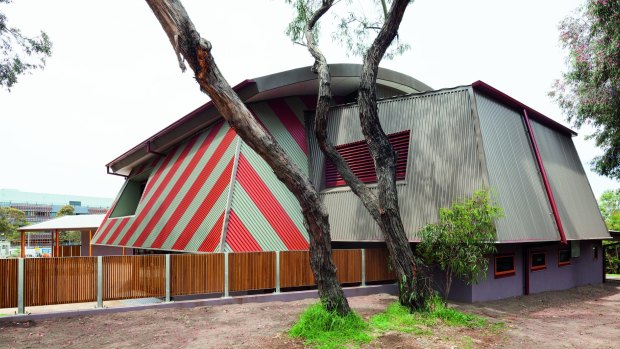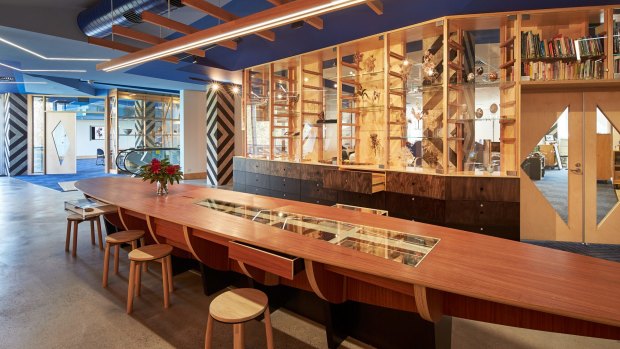By Ray Edgar
Architect Carey Lyon admits his generation has a "blind spot" regarding Indigenous culture. After working on the Koorie Heritage Trust fit-out at Federation Square, Lyon has the conviction of a man who's been taught to see. Collaborating with Aboriginal architect Jefa Greenaway and graduate architect Rueben Berg opened his eyes.
"[Lyons Architecture] walked in and saw an empty, beautiful, LAB-designed building," recalls Lyon. "Rueben and Jefa walked in and saw the building's relationship to the Yarra, which is obviously a significant cultural place within the heritage of the Indigenous owners. Their first thought was 'we've got to find a way to turn this fit-out around and face the river instead of the square'."

Deakin University Geelong 's Institute of Koorie Education designed by Greg Burgess. Credit: John Gollings
The view of the river was overlaid with text, with its real Aboriginal name Birrarung – River of Mist (Yarra, Yarra was a misinterpretation). Diamond shield patterns were used as motifs through the building. The main gathering table Greenaway designed takes the form of a traditional bark canoe, but made with contemporary techniques. Joinery evokes the banks of the river, while the concrete treatment echoes the river bed.
"The idea was about constructing a landscape in the interior," says Greenaway.

Koorie Heritage Trust Gathering table designed by Jefa Greenaway.Credit: Peter Bennetts
"It becomes a whole narrative about reconnecting to country, albeit in a modest way," says Lyon.
As founders of Indigenous Architecture and Design Victoria (IADV), Berg and Greenaway believe design can promote cultural understanding, if not reconciliation. Founded in 2010, the consultancy's approach is one of inclusion.
"It's a powerful connection for [non-Aboriginal] people to be able to think 'I'm living on a place where other people lived for tens of thousands of years'," says Berg. "So they don't see [Aboriginal] culture as some other thing. We're just all a continuation of that [history], because we're living on this place."
There are many ways to engage with aboriginal cultural values, says Berg – from obvious methods of incorporating motifs to more subtle techniques of planning shared spaces instead of separate rooms. The park on the grounds of the old children's hospital takes its cues from the Aboriginal seasons. Artworks on footpaths, murals and street signs also contribute in their small way to recognising the cultural history.
"Anything is better than nothing," says Berg.
Berg even sees the contentious Portrait Building designed by ARM architects depicting Aboriginal elder William Barak as positive: "The Barak building has its drawbacks, but it's moving us in the right direction. It's a very powerful reminder of where we are as a society. Twenty years ago there's no way anyone would think that a way to make money would be to put an Aboriginal face on it. Now [developers and architects] think it might give a sense of connection to the community."
Far from being once bitten twice shy, developer Grocon also see the Barak experience as positive and intend to directly engage IADV on future development projects. "We're looking forward to further opportunities that IADV might help us understand, explore and celebrate," says David Waldren, Grocon's head of culture and innovation. "They offer an expertise in linking to the network of experts on Aboriginal culture."
IADV also raises awareness within the Aboriginal community about the powerful role design can play. "[Typically] if an Aboriginal kid wants to go to university they study law or medicine or social work to have a direct impact on the community," says Berg. "Another way to help community and strengthen culture is by having buildings and places that reflect us."
Like sustainability, Aboriginal culture should be a normal consideration in the design process.
Berg stresses that the IADV offers "an" Aboriginal perspective: "There is no such thing as 'the' Aboriginal perspective." It requires consultation, research and knowledge.
Opening the senses to Aboriginal culture largely involves listening and empathy, says architect Greg Burgess. "It's not for the fainthearted." For 45 years Burgess, who mentored Greenaway and Berg, has worked with Indigenous communities on numerous projects including Deakin University Geelong's Institute of Koorie Education and the Brambuk cultural centre in the Grampians (Gariwerd).
"Part of the Brambuk process was to understand and feel and hear about the tragic history," says Burgess. "These people suffered rampant genocide and stolen generation kids. It's not healthy to deny it or suppress it. Part of the conscious evolution of the project was to let some of these things have expression in the building. It twists and warps and bears down, reflecting both suffering and hope. Buildings have got limits to what they can do. But there's a profoundly healing process in listening, dialogue and ideas."
Largely institutional and community buildings have led the way. But it's not just Koorie buildings that should be the subject of research, says Berg: "It doesn't matter what sort of project it is, you should think about this, because you're building on an Aboriginal place no matter where it is."
Like sustainability, Aboriginal culture should be a normal consideration in the design process.
Yet why, after all these years, is momentum building now? Comparative history offers one explanation. Indigenous societies maintained the environment for thousands of years, while First-World capitalism is rapidly destroying it. Youthful idealism and generational change is another reason. Carey Lyon sums up this evolving approach to placemaking.
"It's not possible to suppress something that's so powerful as the idea of the original inhabitants, the original culture still being a living culture in a city," Lyon says. "How can you not eventually accept that that's going to be brought out into public light and celebrated and be an integral part of the way the city views itself? Otherwise it's kind of nuts."